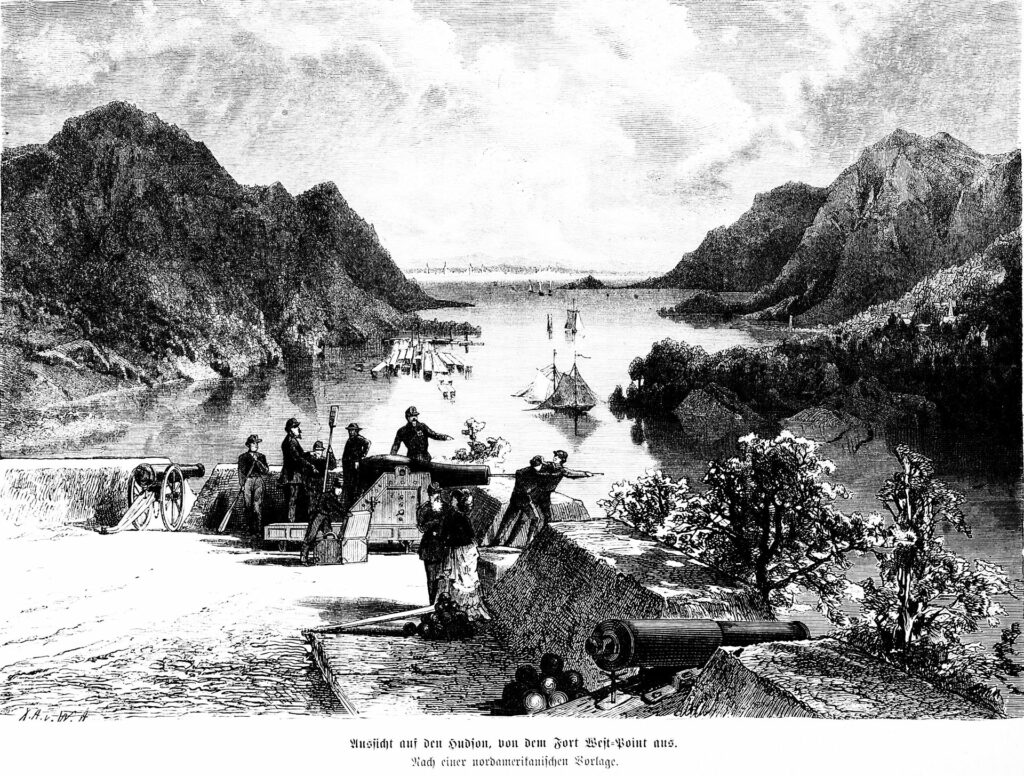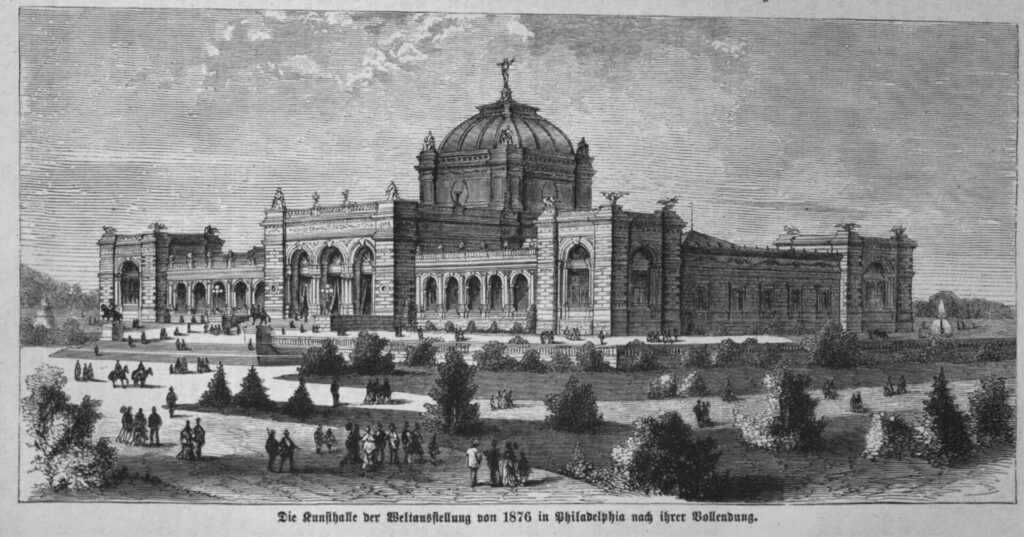What Did They Know?
A Miniseries on Prospective Baden Migrants and Their Knowledge of America in the 1870s and 1880s
With contributions by Martin Bemmann, Marie Nella Hoffmann, Hannah Laubrock, and Luca Leitz-SchwoererDuring the second half of the nineteenth century, family magazines in Germany gained more popularity and eventually became mass media. Therefore, studying magazine publications from the time shortly before and during the third emigration wave from Baden to the United States in the 1880s1 can provide vital insight into the knowledge potential migrants may have possessed. Accordingly, we studied two popular, weekly family magazines with the goal of discovering articles related to America. Our investigation did not solely aim to uncover information concerning the process of migration itself but to find general information about America that these magazines presented to potential migrants. This information, whether or not it was accurate, may have influenced potential migrants’ decisions, so it is important to discern what kinds of knowledge they could have derived from it.
To be sure, one has to use caution in analyzing and using such sources. Magazines were just one medium out of many conveying information about America at that time. Furthermore, individuals must process information and interpret it, which means different individuals can draw different conclusions from the same information. Also, readers were likely to have encountered contradictory information not only between the two magazines, but also in each magazine itself. Consequently, one can assume that readers did not take in the information without question but rather reflected on it in light of their own life experiences, their expectations, and other sources of information, and then chose to disregard it or incorporate it into their individual store of knowledge about America. Thus, analyzing articles helps us to determine what images of America potential migrants may have had in their minds when starting their journey. Generally, the results should be viewed within the more global context of this miniseries about the third migration wave from Baden to America. Taken together, the different sources reveal a host of possible migrant knowledge from which potential migrants could form their own picture of America.

The first magazine we investigated, Die Gartenlaube, founded in 1853 in Leipzig, was one of the first of a newly emerging type of family magazines. Over time, it became the most popular German family magazine, even transcending German borders.2 The second magazine, Deutscher Hausschatz in Wort und Bild, was similar in type but was founded over twenty years later in 1874. Eventually, it also became one of the most popular family magazines in Germany. While Die Gartenlaube considered itself liberal, Deutscher Hausschatz could be seen as a more conservative, Catholic counterpart to it.3 Both magazines were able to gain such popularity partly because they were written for a broad audience and not exclusively for academics or highly educated people: they used simple language and, even more importantly, covered a variety of topics, as we will see below. Generally, both magazines featured articles and illustrations about science, history, sociology, as well as fiction and literature. Interestingly, as will become evident below, the images both magazines painted of America were highly ambivalent. In each magazine, different aspects of America were covered, though we will not examine all of them in detail here. Some of the topics we explore more extensively are culture, society, urbanity, traffic, and industrialization, as well as German migration to America itself. Rather prominent topics in both magazines that we do not cover in detail here are religion, such as churches and sermons,4 geography, the descriptions of states and nature,5 and literature, including fictional novels and stories set in America.6 Finally, it is important to note before moving on to our analysis of the articles that the style of writing in both magazines was generally very polemic. However, as both magazines aimed at entertaining a broad audience, this is not too surprising.
The articles we analyzed were all printed in magazine issues published between 1870 and 1880. Because Deutscher Hausschatz did not begin publication until 1874, the selection is obviously limited to articles from that year on. It is likely that both magazines were widely known and read in our area of interest, Baden, as they can be found in the libraries of the big cities of Freiburg and Lahr, respectively.7 Their reader-friendly and entertaining qualities, discussed above, further foster this assumption. Yet we make no claim to completeness here: there were many other similar family magazines at the time of the third migration wave that we did not analyze.

Both magazines frequently featured articles and stories about German migration to the United States of America and on German-American identity. In a Gartenlaube article of 1880, for example, potential migrants were warned of agencies that, upon arrival in New York, would lure them into working contracts that would turn out to be exploitative and beneficial to the agencies.8 Similar cases were reported in Pennsylvania,9 one of the main German settlement areas to this day.10 While such stories may not have particularly encouraged potential migrants, other articles delivered more comforting information. For example, in another Gartenlaube issue from 1880, an article shed light on the German Society in Pittsburgh, which was founded to help migrants find jobs and protect them from scammers.11 Articles concerning migration were also frequent in Deutscher Hausschatz; an 1874/75 issue even had an article explaining the political and economic circumstances that prompted the first two German migration waves to America.12
American travel and transport by train, boat, or cable car were prominent topics in both magazines. A Gartenlaube article of 1876, for example, was filled with sarcastic jokes about the differences between German and American railways and trains, highlighting American superiority.13 There were also various reports on business traffic on rivers14 and on cable cars in Philadelphia and San Francisco. Another article on cable cars in San Francisco recommended that Germans bridge the long waiting times by having a beer in one of the city’s pubs.15 The evident fascination for the new forms of transport seemed to be linked to the more global topic of industrialization, which, by transforming society as a whole, affected the everyday lives of people both in Germany and in America, constituting an important factor for potential migrants. New modes of transportation had a tremendous impact on human-work relationships, breaking up former rural structures and producing a new kind of “working men,” as can be seen in the number of articles about new industries in both magazines.16 New industries and transportation technologies also fostered capitalism and ushered in a new form of mass consumption. Such consumption was on prominent display in the Centennial Exhibition in Philadelphia in 1876, to which both magazines devoted considerable space. Deutscher Hausschatz, for its part, published numerous articles about the event featuring all kinds of businesses and branches of industries, such as modern farming, mining, and different kinds of craftsmanship.17 Arguably, the rise of capitalism and industrialization may have been at the center of attention for many potential migrants since they had to find new ways to sustain themselves and their families. Furthermore, potential migrants from rather rural Baden were likely fascinated by the parallel emergence of new forms of urbanity and the rapid growth of cities, which arguably made these strong pull factors.
The two magazines also covered American society and the nation’s “way of life” frequently, publishing reports that painted a highly ambivalent picture.18 While many articles praised American generosity in the establishment of welfare projects like the Children’s Aid Society, libraries, and hospitals, others commented rather negatively on America’s wealth and dissolute lifestyle. Chasing the “almighty dollar”19 was seen as a fundamental ambition in the whole of American society in the cities, leading to a hectic lifestyle and the absence of leisure and intellectual activity. Another issue compared this rat race to Germany’s calmer and less excessive way of life and found it to be inferior.20 Articles in Deutscher Hausschatz and Die Gartenlaube commented on the excessive consumption of alcohol and other narcotics in American society, respectively.21
The American way of life was apparently perceived to be closely connected to – maybe even deriving from – the broad idea of “republican freedom,” which was arguably the most central value in American society. Ludwig Büchner, a German doctor and philosopher, stated that this feeling of freedom was deeply ingrained in the minds of Americans and crucially important to the country’s successful migration culture. On the other hand, Büchner pointed out, the feeling of freedom also reinforced a feeling of entitlement within individuals, leading to excessive arguments that could cause interruptions and delays in everyday life, for example, in university lectures.22 Multiple issues of Die Gartenlaube described the cultural enrichment German immigrants brought to American society. Examples it provided included the German-American press23 and the superiority of German and European art.24 However, as mentioned above, many other reports revealed that some images of America making their way across the Atlantic Ocean were inaccurate or exaggerated, so they shed a more positive light on American society and culture. An 1876 article in Die Gartenlaube for example, argued that chaos and bluntness were not as present in American everyday life as often stated elsewhere.25
This high level of ambivalence in and between reports is precisely what leads us to conclude, as we stated at the outset, that potential migrants were certainly not presented with an unequivocal, clear set of images of America shaping some kind of “shared knowledge bubble.” Rather, they encountered highly differing accounts and depictions of similar topics, sometimes just a few pages apart. Emigrants most likely chose what to believe and what not to believe on the basis of their individual goals, expectations, and priorities. Therefore, as already implied, historians should be careful in forming hypotheses about the existence of some sort of “prevalent” perception of America shared among potential migrants and, perhaps, avoid them altogether.

- Alexandra Fies, “Die badische Auswanderung im 19. Jahrhundert nach Nordamerika. Unter besonderer Berücksichtigung des Amtsbezirks Karlsruhe zwischen 1880–1914” (PhD diss., U Karlsruhe, 2010), 95. ↩︎
- Undine Jancek, Zwischen Gartenlaube und Karl May: Deutsche Amerikarezeption in den Jahren 1871–1913, Berichte aus der Geisteswissenschaft (Aachen, 2003), 192. ↩︎
- Christof Hamann, “Der perfekte realidealistische Held. Karl May als Autor des Deutschen Hausschatzes in Wort und Bild,” in Medialer Realismus, ed. Daniela Gretz, 145–65 (Freiburg, 2011), 148. ↩
- Die Gartenlaube 22 (1872): 365–66, 365. ↩︎
- Deutscher Hausschatz 32 (1877/1878): 511; Die Gartenlaube 49 (1872): 812–13. ↩︎
- Deutscher Hausschatz 26 (1878/1879): 405. ↩︎
- Bücherverzeichnis der Volksbibliothek Freiburg (Freiburg, 1899), 102ff.; cf. Bücherverzeichnis der Stadtbibliothek Lahr (Lahr, 1899), 140. ↩︎
- Die Gartenlaube 1 (1880): 20. ↩︎
- Die Gartenlaube 8 (1879): 139–40, 139. ↩︎
- Karl-Heinz Meier-Braun and Reinhold Weber, Kleine Geschichte der Ein- und Auswanderung in Baden-Württemberg (Leinfelden-Echterdingen, 2009), 88. ↩︎
- Die Gartenlaube 27 (1880): 448. ↩︎
- Deutscher Hausschatz 10 (1874/1875): 160. ↩︎
- Die Gartenlaube 13 (1876): 215–17. ↩︎
- Die Gartenlaube 11 (1876): 184–87, 184. ↩︎
- Die Gartenlaube 29 (1877): 489–91, 489. ↩︎
- Deutscher Hausschatz 49 (1876/1877): 784; Die Gartenlaube 9 (1880): 151–52; Deutscher Hausschatz 6 (1877/1878) 92. ↩︎
- Deutscher Hausschatz 31 (1875/1876): 493; Die Gartenlaube 29 (1877): 489–91; Deutscher Hausschatz 23 (1874/1875): 357. ↩︎
- Die Gartenlaube 46 (1874): 742–45, 743; Die Gartenlaube 6 (1874): 97–99. ↩︎
- Die Gartenlaube 46 (1872): 725. ↩︎
- Die Gartenlaube 4 (1873): 64–67, 66. ↩︎
- Deutscher Hausschatz 29 (1878/1879): 464; cf. Die Gartenlaube 13 (1874): 210–13. ↩︎
- Die Gartenlaube 46 (1872): 725–26. ↩︎
- Die Gartenlaube 36/47 (1875): 609–11/791–94, 610. ↩︎
- Die Gartenlaube 41 (1874): 668–69, 668. ↩︎
- Die Gartenlaube 29 (1874): 462–46; Die Gartenlaube 11 (1876): 184–87.

What Did They Know?: An Introduction to the Miniseries



Rübelmann’s Letters: Knowledge Transfer through Emigrant Correspondence


